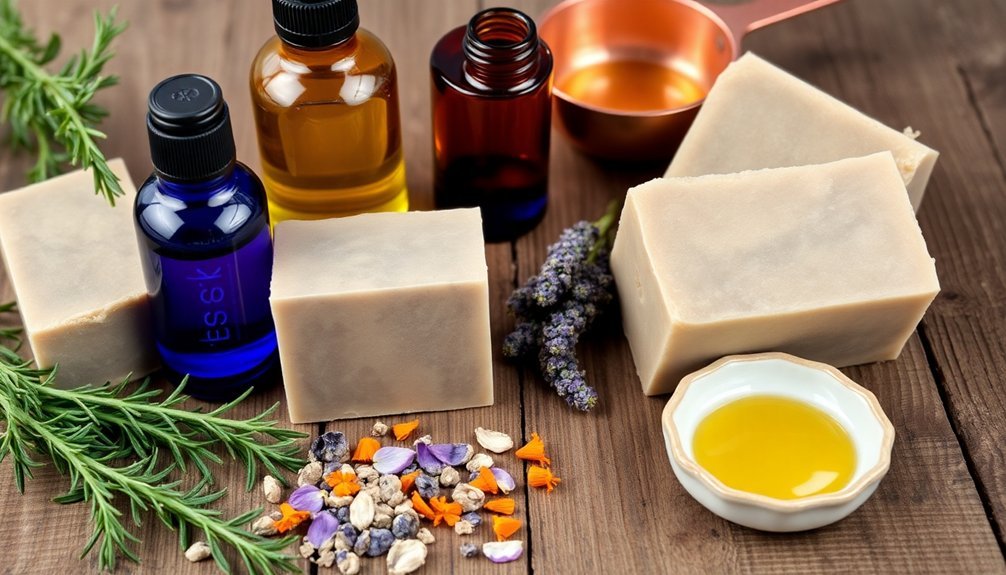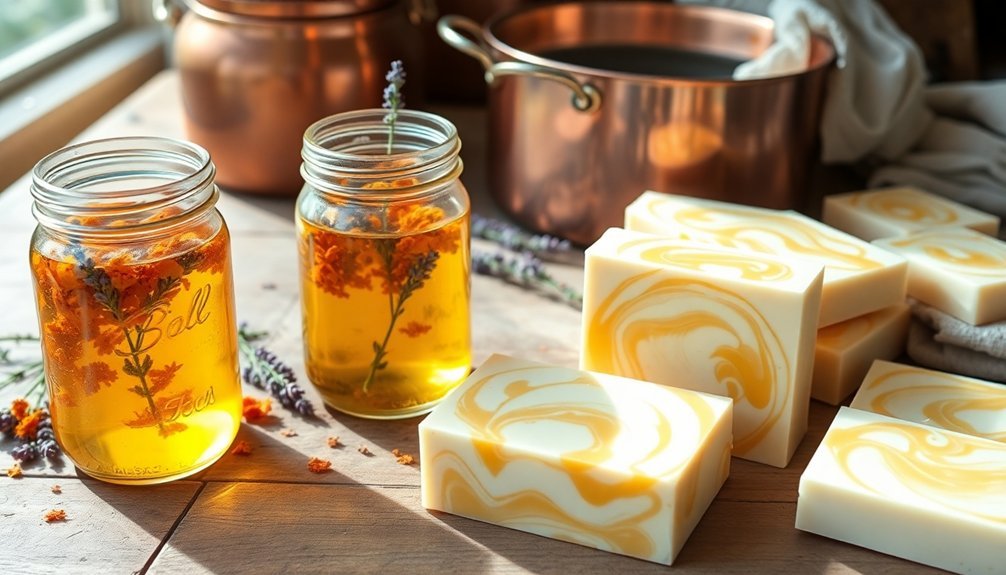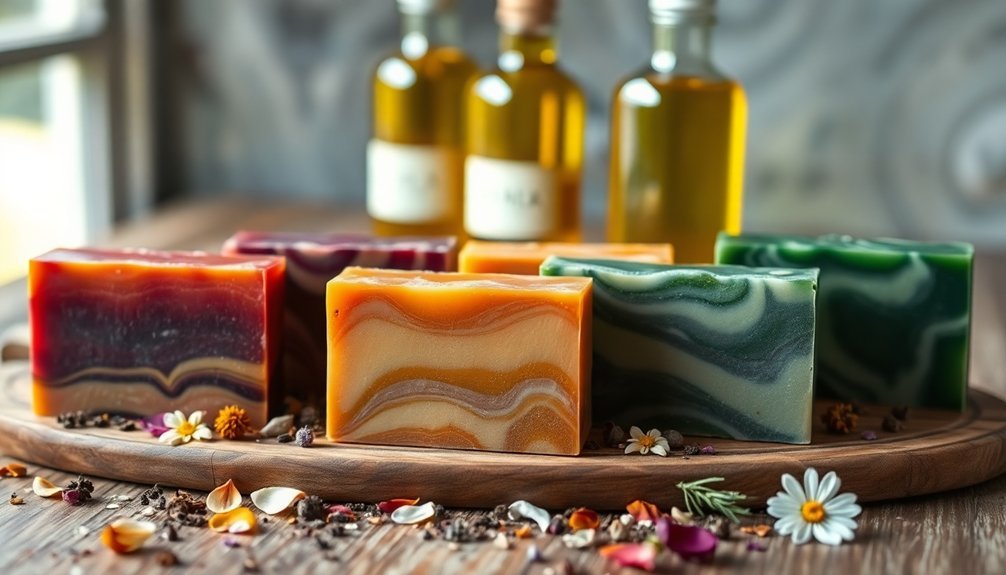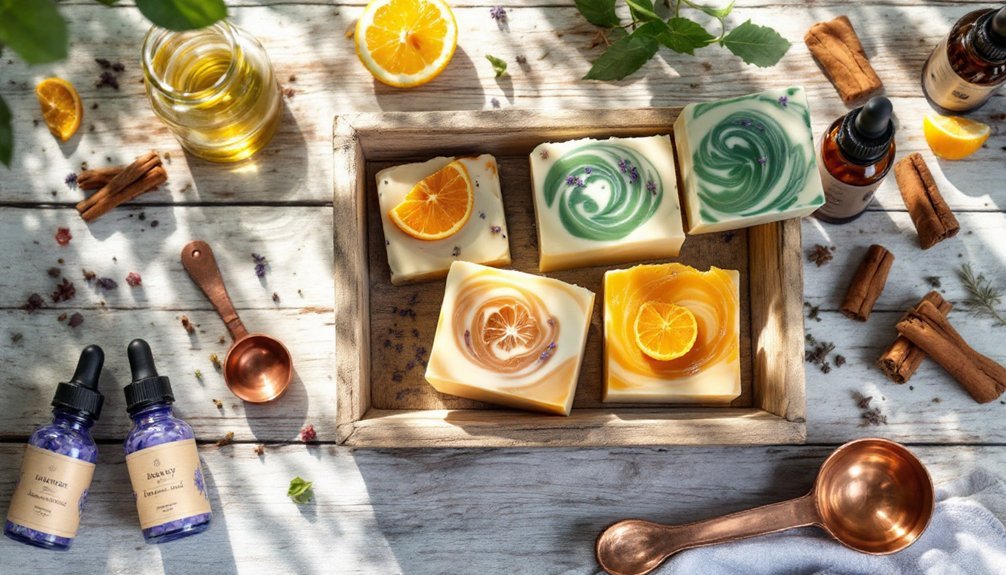Making natural oil-infused soaps starts with choosing dried botanicals and compatible carrier oils like olive oil. You'll need basic equipment including a digital scale, thermometer, and protective gear for safety. Through either slow cold infusion or quick heat methods, you'll create vibrant, therapeutic blends that enhance your soap's color and benefits naturally. Keep your infusions in dark, airtight containers for ideal freshness. Let's explore the artistry of transforming ordinary oils into extraordinary soaps.
Understanding the Art of Oil Infusion for Soap Making

Three essential techniques set oil infusion apart in the art of soap making, with the process allowing you to harness nature's beneficial properties without compromising texture.
You'll discover that infused oils enhance your soap's natural qualities while maintaining a smooth, professional finish.
When crafting your infusions, you can choose between two primary methods: a slow cold process that takes several weeks or a quick heat method completed in hours.
While fresh herbs might seem appealing, they're not your best choice for long-term stability. Instead, opt for dried botanicals to prevent mold growth and guarantee consistent results.
Remember to keep your herbs completely submerged in carrier oils like olive oil throughout the infusion process.
You can substitute these infused oils for a portion of your regular soap recipe's oils to add both color and beneficial properties.
Essential Equipment and Safety Measures

Before you start crafting natural oil-infused soaps, you'll need proper protective gear including chemical-resistant gloves, safety goggles, and a face mask to shield yourself from lye fumes.
You'll want to gather essential tools like a digital scale, thermometer, immersion blender, and sturdy mixing containers made of stainless steel or heavy-duty plastic.
Store your equipment and raw materials in a well-ventilated, dry space away from children and pets, keeping lye in a locked cabinet and oils in dark, cool containers to maintain their integrity.
Protective Gear Requirements
Safety comes first when making natural oil-infused soaps, and proper protective gear is non-negotiable.
You'll need protective gloves that can withstand caustic substances and safety goggles to shield your eyes from any lye splashes. Never handle lye without these essential items, as it can cause severe burns.
When measuring ingredients with your digital scale and mixing with an immersion blender, ascertain you're working in a well-ventilated space to avoid inhaling harmful fumes.
Choose heavy-duty plastic or stainless steel containers for mixing your soap ingredients, as lye can react dangerously with other materials.
Remember to keep your protective gear in good condition and replace any worn items immediately.
Don't skip these safety measures – they're vital for a safe soap-making experience.
Safe Storage Solutions
Proper storage of your oil-infused soaps and ingredients determines their longevity and effectiveness. To protect your infused oil supplies, store them in airtight containers like glass jars or plastic bottles.
Keep these containers in a cool, dark space away from direct sunlight and heat sources to maintain their shelf life and prevent degradation.
Always label your containers with the infusion date and contents, making it easy to track freshness and avoid mixing up different oils.
You'll need to use clean, sterilized equipment when handling and storing your supplies to prevent contamination.
Regularly inspect your stored oils for any signs of spoilage, including unusual odors or color changes.
If you notice anything suspicious, don't take chances – discard the compromised oils immediately to maintain the quality of your soap-making ingredients.
Essential Tools Checklist
Three fundamental categories of equipment form the foundation of safe, successful soap making: measurement tools, mixing equipment, and protective gear. You'll need essential equipment like an accurate digital scale to weigh water and oils separately, guaranteeing precise ratios for proper saponification.
| Category | Essential Items | Safety Purpose |
|---|---|---|
| Measuring | Digital Scale, Thermometer, Lye Calculator | Precise Ingredient Ratios |
| Mixing | Immersion Blender, Heavy-duty Containers | Effective Blending |
| Protection | Gloves, Goggles, Ventilation | Personal Safety |
Before starting your soap-making journey, verify your workspace is clean and well-ventilated. Keep safety measures at the forefront by always wearing protective gear when handling lye. Store your tools separately from kitchen equipment and maintain sterile conditions to prevent contamination of your natural oil-infused soaps.
Selecting the Right Oils and Botanicals

When starting your oil-infused soap journey, you'll want to pair compatible oils and botanicals that work harmoniously together, such as lavender with olive oil or chamomile with sweet almond oil.
You'll achieve the best results by selecting dried herbs and flowers that are known for their infusion properties, including calendula, rose petals, and comfrey leaves, while ensuring they're completely covered in your chosen carrier oil.
Store your infusions in dark glass containers away from direct sunlight, and remember that properly prepared infusions using shelf-stable oils can last up to a year when maintained at room temperature.
Essential Oil Pairing Basics
Selecting the right essential oils for your handmade soap requires understanding both their therapeutic benefits and aromatic harmony.
When choosing your combinations, pair complementary scents like citrus with floral notes—orange blends beautifully with ylang-ylang, while lemon works well with jasmine to create balanced, sophisticated fragrances.
Remember to take into account the therapeutic properties of each oil. Lavender offers calming benefits, while peppermint provides an invigorating effect.
You'll want to maintain proper ratios, using 0.5 to 1 ounce of essential oils per pound of soap base for ideal potency. Before finalizing your blend, conduct a patch test to verify skin compatibility.
For added uniqueness, try incorporating infused oils from herbs like rosemary or chamomile, which can enhance both the aromatic profile and skin-nourishing qualities of your soap.
Best Botanicals for Infusion
The art of botanical infusion starts with choosing the right ingredients for your homemade soaps. When selecting botanicals for infusion, you'll want to use dried herbs rather than fresh ones to prevent mold growth. Popular choices like calendula, chamomile, and lavender not only add beautiful natural colors but also bring their unique properties to your soap.
For the best herbal infusions, choose a stable carrier like olive oil or jojoba oil. These provide an excellent base for your infused oils and guarantee a longer shelf life.
Here's why proper botanical selection matters:
- Ground herbs infuse more quickly but require careful measurement to avoid overwhelming scents.
- Dried botanicals create shelf-stable infusions that won't spoil your soap.
- Well-chosen herbs can transform your soap from simple to spectacular with natural colors and properties.
Storage and Shelf Life
Proper storage of your oil-infused soap ingredients dramatically affects their longevity and potency. To maximize shelf life, store your infused oils in sterilized jars and keep them in a cool, dark place, where they'll stay fresh for up to 1-2 years when using stable bases like olive oil.
When working with botanicals, you'll get better results using dried herbs instead of fresh ones, as they're more stable and provide longer-lasting benefits.
Make sure your herbs remain completely submerged in the oil to prevent mold growth. If you're using ground herbs, you'll need less quantity while achieving better surface exposure for infusion.
Consider how different botanicals interact with your chosen oils, as some combinations may degrade faster than others. This compatibility factor directly impacts your final product's storage duration and effectiveness.
Traditional Infusion Methods and Techniques

Creating oil infusions for natural soaps begins with two time-tested methods: slow infusion and quick infusion.
The traditional infusion method requires wilting fresh herbs, chopping them finely, and packing them in a jar with oil to bask in sunlight for several weeks.
Sun-kissed herbs and golden oils dance together in glass jars, creating nature's essence through patient, time-honored tradition.
For quicker results, you can heat dried herbs in oil using a water bath for 2-3 hours.
When working with infused oils, you'll discover:
- The magical transformation of ordinary oils into vibrant, herb-enriched blends
- The satisfaction of creating natural colorants that won't leave grainy textures in your soap
- The joy of preserving nature's essence in your handmade creations
Remember to keep your herbs fully submerged in oil to prevent mold, and choose dried herbs for longer shelf life in your infusions.
Natural Coloring Through Oil Infusions

Building on these traditional infusion methods, natural colorants offer an artistic dimension to your soap-making journey.
You'll discover that infused oils create vibrant hues in your handmade soap without the grainy texture that powders can leave behind.
Whether you choose cold infusion for a 2-6 week steeping process or heat infusion for quicker results, you'll find endless color possibilities.
Try alkanet root for purple tones, turmeric for golden yellow, or paprika for warm orange shades.
When working with these natural colorants, select long-lasting base oils like olive oil for your infusions.
You can control color intensity by adjusting the amount of infused oil in your recipe.
For even more vibrancy, consider combining your colored oils with lye-infused water. This dual approach maximizes the natural pigments' potential in your final product.
Troubleshooting Common Infusion Challenges
While infusing oils for natural soap colorants can be rewarding, you'll likely encounter several common challenges that can affect your final product's quality.
Natural oil infusions create beautiful soap colors but require careful attention to detail for achieving the best results.
Look out for cloudiness or sediment in your infused oil, as this warns that your herbs aren't fully submerged. Always guarantee complete botanical coverage to prevent mold growth.
When working with herbs, remember these essential points:
- Choose dried herbs over fresh herbs for longer-lasting, more concentrated infusions.
- Monitor your infusion duration carefully to avoid unwanted odors.
- Keep tea bags fully submerged for ideal oil penetration.
If your infusion lacks color intensity, try extending the infusion time or gently heating the mixture.
For deeper pigmentation, consider increasing your herb-to-oil ratio or switching to potent botanicals like alkanet or turmeric.
Recipes and Creative Applications
Three essential oil-infused soap recipes showcase the versatility of natural colorants and botanical benefits.
You'll love the soothing Lavender Infused Soap, which combines lavender-infused olive oil with lye and water for a calming natural soap experience.
For a vibrant twist, try creating a cold process soap using marigold or hibiscus-infused oils, which deliver stunning colors and gentle fragrances without any artificial additives.
Looking for an energizing morning option? Infuse your essential oil blend with fresh mint leaves, then combine it with coconut oil and shea butter.
This invigorating combination creates the perfect wake-up soap.
The beauty of using infused oils in your soap making lies in their ability to incorporate botanical benefits while maintaining a smooth, luxurious texture – no gritty remnants like you'd find with powdered herbs.
Frequently Asked Questions
What Are the Best Oils to Add to Homemade Soap?
You'll get the best results by combining olive oil for gentle cleansing, coconut oil for lather, and sweet almond, jojoba, or avocado oil for moisturizing. Each brings unique benefits to your soap.
How to Make Infused Oil for Soap Making?
Pack dried herbs in a jar, cover with olive oil. You'll need to let it sit for 2-6 weeks in sunlight, shaking occasionally. Alternatively, heat the jar in a water bath for 2-3 hours, then strain.
What Essential Oils Should Not Be Used in Soap?
You shouldn't use cinnamon, clove, oregano, high concentrations of peppermint or wintergreen, citrus oils, camphor, or pine oils in soap. These can cause skin irritation, sensitivity, or potentially harmful reactions.
What Are the Three Items Added to Soap to Improve Its Value?
You'll enhance your soap's value by adding natural exfoliants like oatmeal for texture, moisturizing agents such as shea butter for hydration, and antioxidant-rich ingredients like green tea for skin benefits.
In Summary
You're now equipped to create beautiful, aromatic soaps using natural oil infusions. Don't be afraid to experiment with different botanical combinations and infusion methods as you develop your signature blends. Whether you're making soap for personal use or as thoughtful gifts, you'll find that mastering oil infusion opens up endless creative possibilities. Remember to document your successes and learn from any challenges along the way.





Leave a Reply